Although I love the four species of doves and pigeons that visit our garden, there are several other species in the country that I have missed seeing in these travel-free times. In this post I showcase the almost ubiquitous ring-necked dove (except in our specific neighbourhood it seems) and the Namaqua dove, which I have mostly seen in the more arid regions.
In our garden red-eyed doves (Streptopelia semitorquata) and laughing doves (Spilopelia senegalensis ) are among the most frequent visitors. Also around, but heard more often than seen are tambourine doves (Turtur tympanistria) and the usually stealthy lemon doves (Columba larvata) formerly known as cinnamon doves.
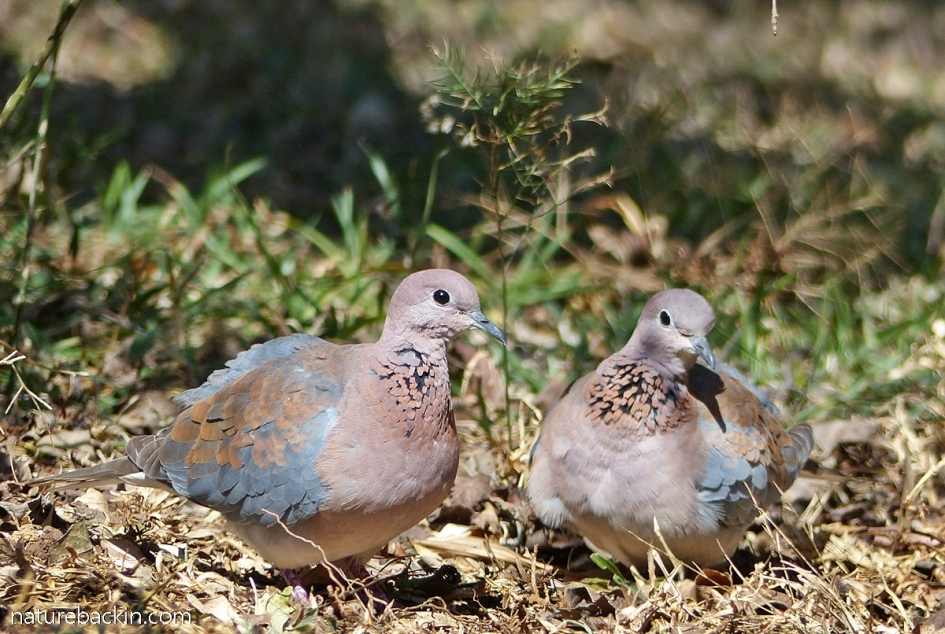
A pair of laughing doves in our garden, showing their delicate colours and subtle markings
Much larger in size than laughing doves are red-eyed doves, but oddly even though they occur commonly elsewhere in the region, in our neighbourhood we never see or hear ring-necked doves (Streptopelia capicola), which are also known as Cape turtle-doves. Perhaps the reason is that ring-necked doves require more open ground for foraging than is available here, whereas red-eyed are quite at home foraging under trees. Although both species may retreat into wooded areas for roosting at night, ring-necked doves are absent from forests, whereas red-eyed doves are known to forage closer to cover including on the verges of forests (Roberts).

A red-eyed dove that I photographed while it was perching in our garden for a preening session
Ring-necked doves readily join other species to form foraging parties on the ground and such foraging groups are a regular feature in farmland areas. However, the photographs featured here were all taken in conservation areas.

This pair of ring-necked doves I photographed late one afternoon in the Mabuasehube region in Botswana in the Kgalagadi Transfrontier Park
Ring-necked doves are usually seen on their own or in pairs, but they can join in large flocks when foraging as already mentioned and also at waterholes especially in semi-arid regions. Like all doves and pigeons, they are monogamous and a pair remains bonded for life. Should one partner die the survivor will seek out another mate.
The monogamous fidelity of doves and pigeons has appealed to human sentiment. Their association with loyalty has not necessarily had a good outcome for the birds themselves. For details on how this association led to turtle doves being used as sacrificial animals see my post Redeyed doves, turtle doves, monogamy and sacrifice.
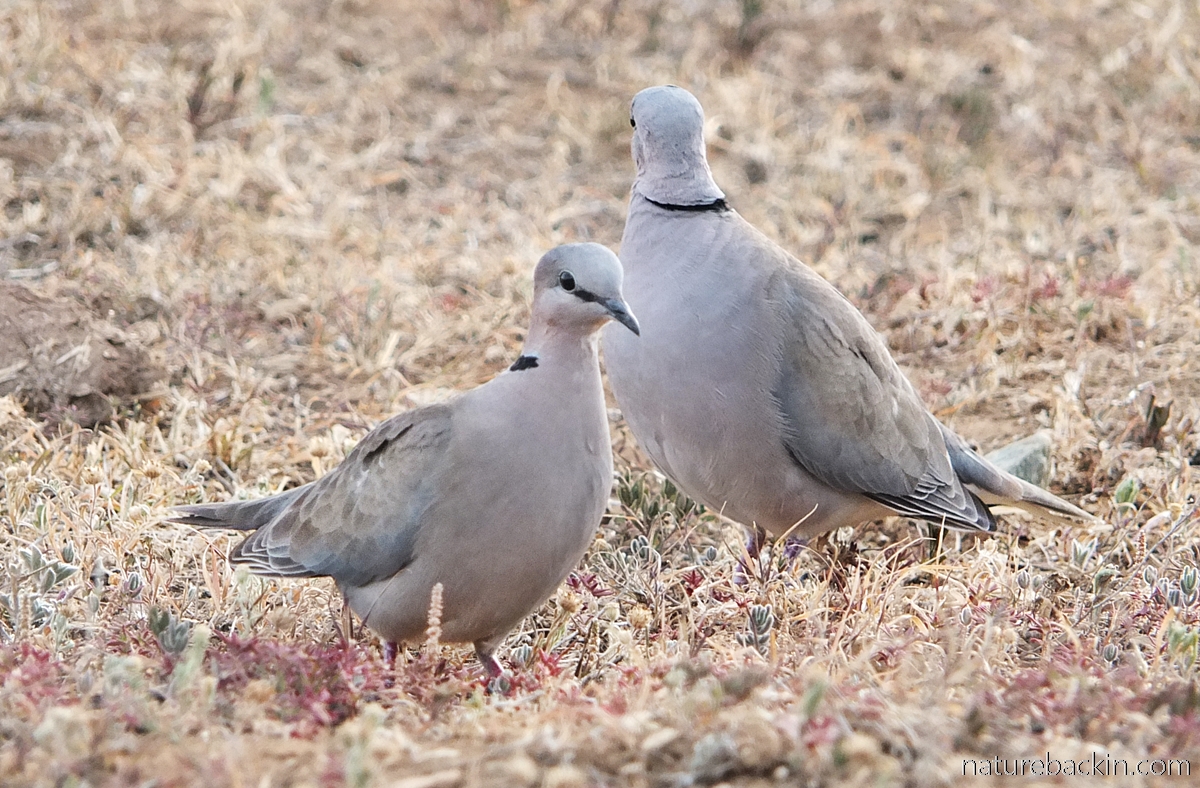
This pair of ring-necked doves was photographed at the Addo Elephant National Park in the Eastern Cape
At waterholes in the semi-arid regions such as Mabuasehube, at certain times of the day birds come and go in almost constant flurries. It is thought that such great activity by aggregations of birds of different species serves to protect individuals against predation by raptors.
On one of our visits, we sat and watched the birds coming and going at a waterhole near Mabuasehube’s Monamodi campsites. The majority of the visiting birds were two species of dove: ring-necked doves and Namaqua doves. In addition to butterflies and other insects attracted to the water, among the other species of visiting birds were shaft-tailed whydahs and Namaqua sandgrouse.

The above photo provides a glimpse of some of the activity as birds arrive to drink and depart in quick succession
Doves and pigeons all belong to the single family Columbidae containing a total of 344 species (thirteen of which are extinct) in 50 genera. There is no scientific distinction between doves and pigeons and in most languages no distinction is made. However, in English the term ‘pigeon’ often – but not always – refers to the larger species of bird and ‘doves’ to smaller species.
Doves and pigeons are among the few species of bird that can drink by sucking and swallowing while the bill is still immersed in the water without the need to raise the head to swallow as in most species of birds.
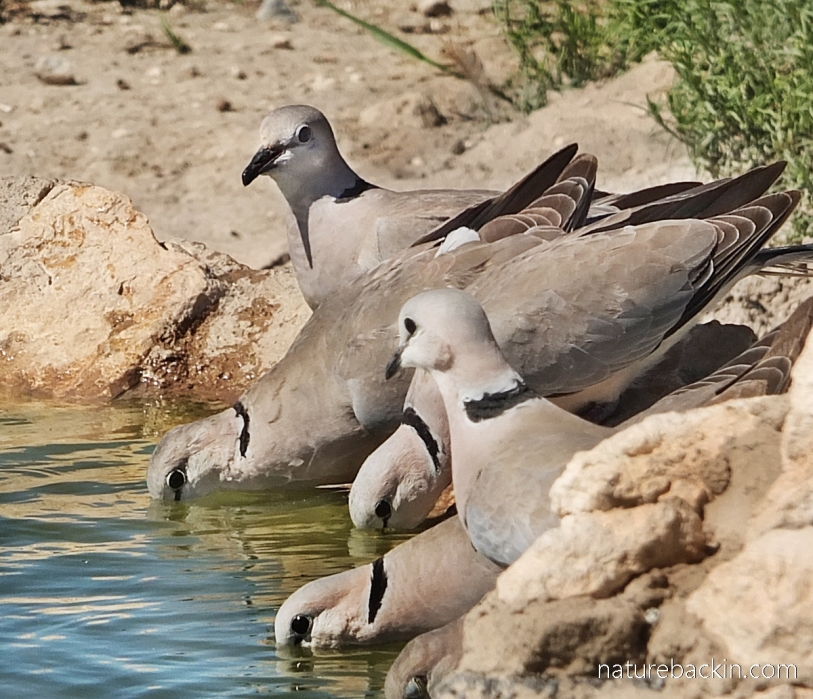
Ring-necked doves at the Monamodi waterhole at Mabuasehube Game Reserve demonstrating how they can drink and swallow without raising their heads
Because they are so exposed to predators when at a waterhole, like most birds doves and pigeons drink quickly and leave as rapidly as they arrived. All members of the Columbidae are strong fliers and they have the ability to take off almost vertically – an acrobatic feat of note. They have large wings proportional to their body size and powerful wing muscles that comprise 31–44% of their body mass.

Even though the rapidly moving wings are a blur in the above photo, the powerful thrust of the wings of this ring-necked dove is clear to see. Drinking in the background is a Namaqua dove with its long tail clearly visible
The Namaqua Dove (Oena capensis) is the smallest dove in Africa and the only one with a long tail. In Southern Africa its distribution is widespread but in some regions, such as where I live, it is an uncommon resident and I have not seen any locally.
I strongly associate seeing Namaqua doves with visits to semi-arid regions, particularly in Botswana, and their most common habitat is semi-arid and arid Acacia savanna, and dry shrublands (Roberts). Where they are common they can often be seen foraging on the ground or perched in shrubs or dry branches, but the most spectacular sightings are at the waterholes where they go to drink in the heat of the day – consequently there are only rare opportunities for golden-hour photography of these birds drinking!

A ring-necked dove pauses from drinking flanked by noticeably smaller Namaqua doves – a male (left) and a female (right)
The average length and mass of a ring-necked dove is 26–28 cm and 150 g and the much smaller Namaqua dove averages only 24–27 cm in length with a weight of a mere 40 g. While comparing the sizes of doves, it is interesting to note that the average size of red-eyed doves is a relatively massive 33–36 cm (length) and 250 g (mass). Laughing doves are a petite 25 cm in length but heavier than Namaqua doves weighing in at about 100g (Roberts).

The black face, throat and upper chest of the male Namaqua doves are distinctive as is the yellow and purple bill
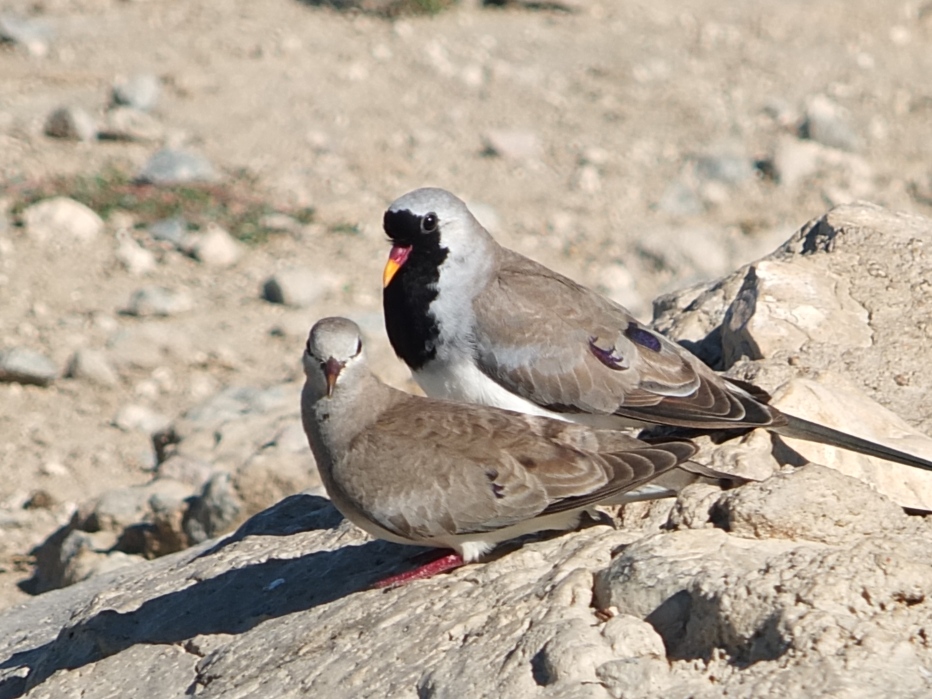
The female Namaqua dove lacks the black markings and bill colouration of the male and is paler in colour, but also has iridescent spots on the wings, broad black and white bars on the upper rump and a long tail
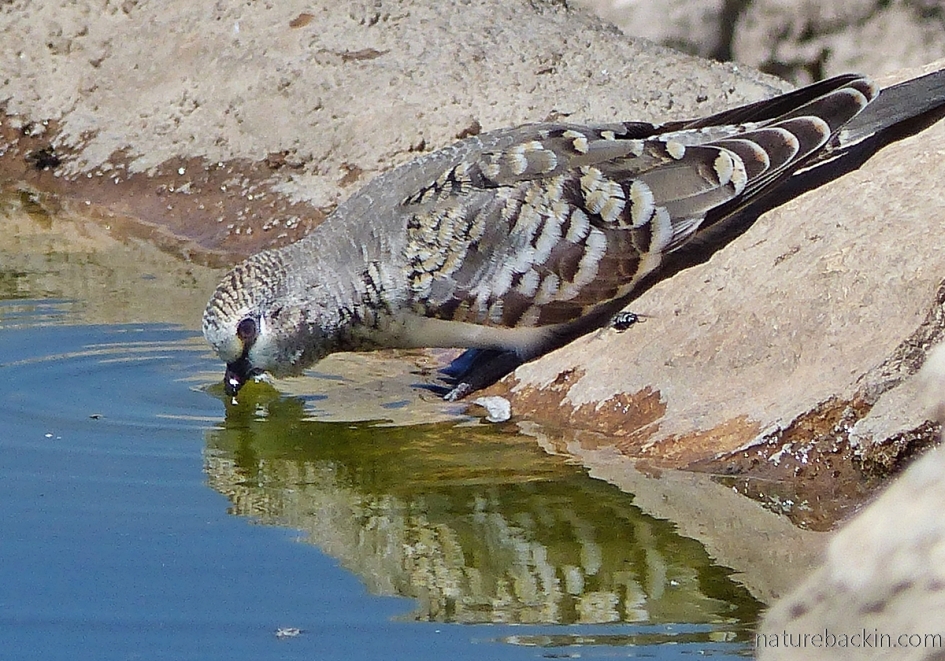
A juvenile Namaqua dove drinking at the waterhole at Mabuasehube shows its beautiful spotted and barred markings

Captured in flight, a female Namaqua dove reveals rufous wing feathers

Unfortunately the bright overhead light was not in my favour when I took this photo of a pair of Namaqua doves with the male sunning himself with an outstretched wing exposing the rufous flight feathers that flash so vibrantly when Namaqua doves are in flight
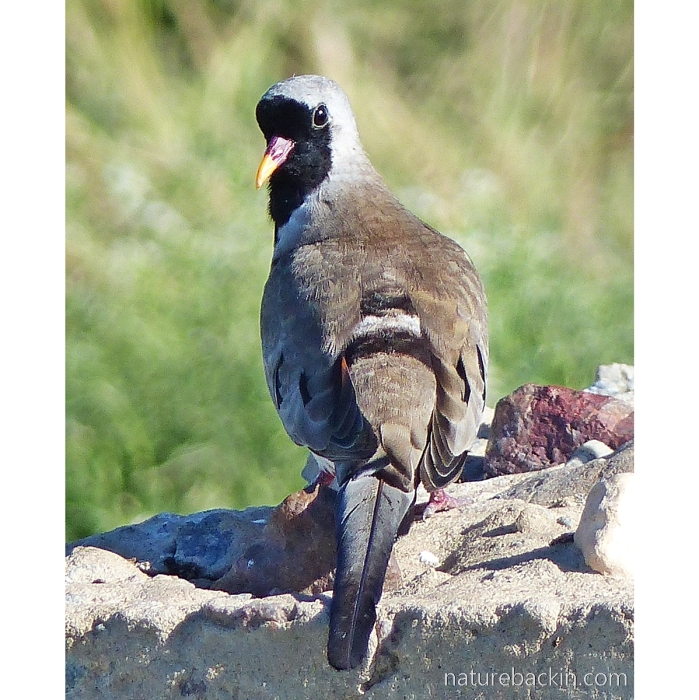
A male Namaqua dove at the edge of the waterhole turned and looked over his shoulder. In this photo the two black bars and one white bar on the upper rump can be seen
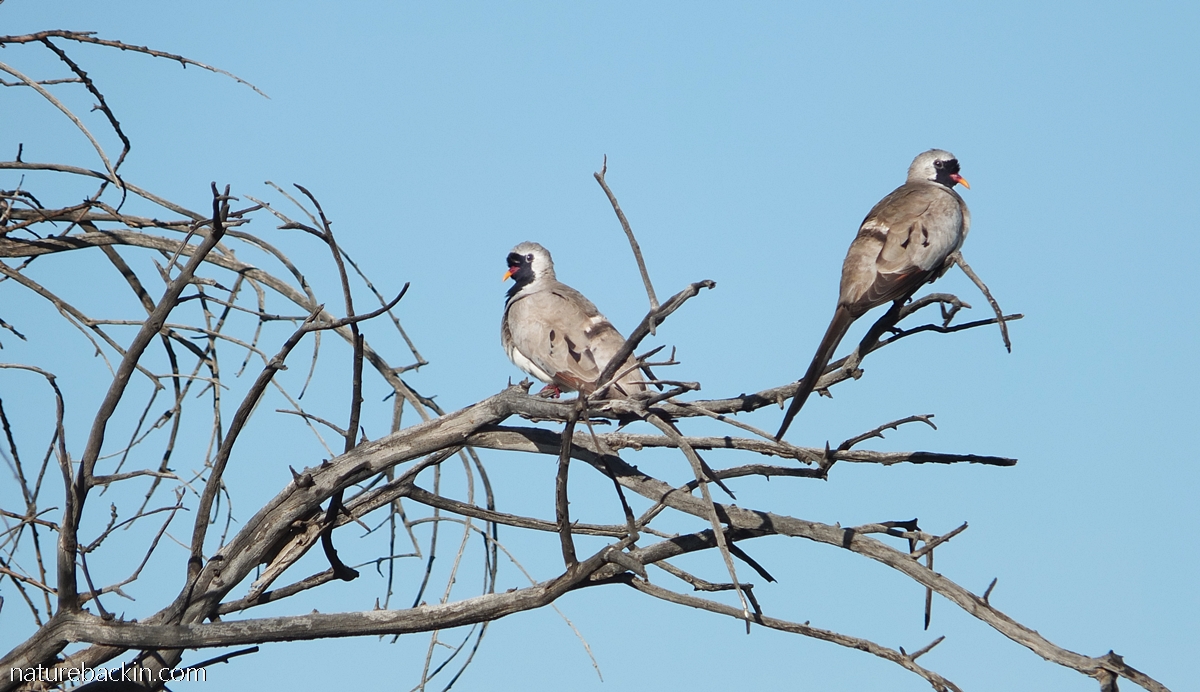
This photo was taken in rather mellower evening light away from the waterhole

But back at the waterhole these Namaqua doves watch rather warily before going down to drink from the relative safety of a distant bush. The reason for their wariness – a raptor had turned up and was on the hunt
The video footage below was taken from the car in the late morning with the sun blazing away almost overhead. Even though taken from a distance it gives an impression of the business of the waterhole as the doves drink almost greedily. In the second clip there is a sudden scattering of the birds.
We had noticed a lanner falcon (Falco biarmicus) perched in a far-off tree that provided a good vantage point over the waterhole. From that far-off perch the falcon would fly in low and at enormous speed, flushing the birds at the waterhole and trying to catch one on the wing as it flew up to try to make its getaway. While we watched the lanner falcon expended enormous energy with repeated efforts to make its catch but each time it came away with empty talons.
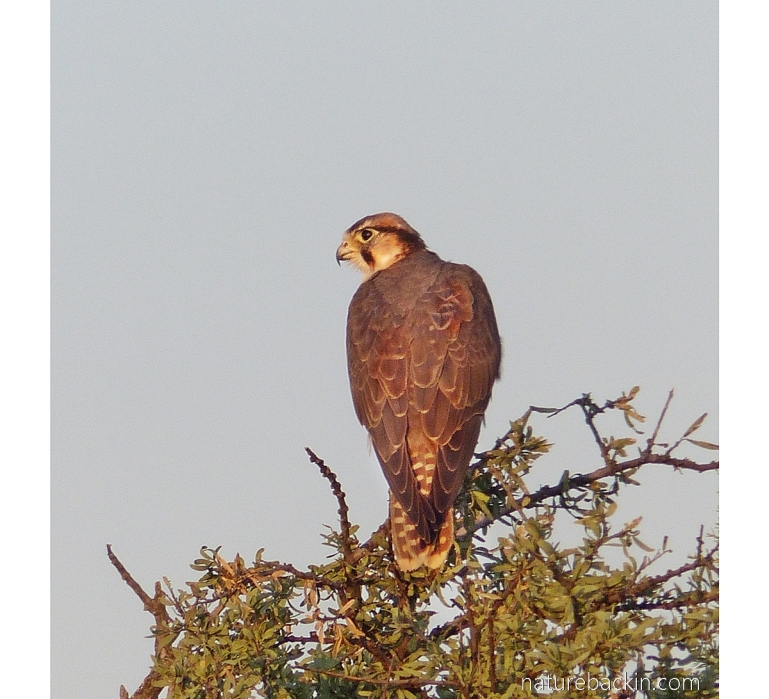
A lanner falcon photographed in the light of the setting sun at the Central Kalahari Game Reserve in Botswana
On one occasion as we watched the falcon take off from its distant perch I started filming the waterhole and so captured the lanner falcon flying in, but it flies in so fast it is actually very hard to see. So, I repeat the clip in slow motion but the bird is still a barely distinguishable blur. I slow it down again and at this very slow speed the falcon can be distinguished as it flies low over the waterhole.

Above is a still from the video at the moment the lanner falcon flies over the waterhole, its reflection is visible in the water. In the first clip the lanner falcon flashes by too fast to really be seen, but seconds later its shadow can be seen as it flies back over the waterhole before returning to its perch
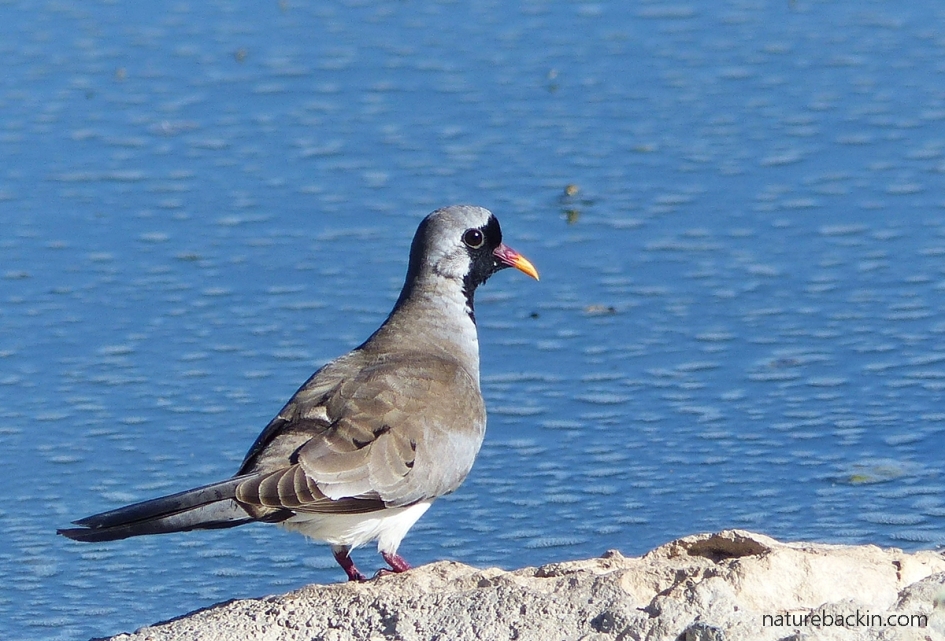
And after each hunting attempt by the lanner falcon, a few minutes later birds would resume coming to the waterhole to drink – thirst is a strong imperative

Sources:
Roberts VII Multimedia Birds of Southern Africa: PC Edition. 1997-2016 Southern African Birding. For details go to http://www.sabirding.co.za/roberts7/portal.html
Posted by Carol

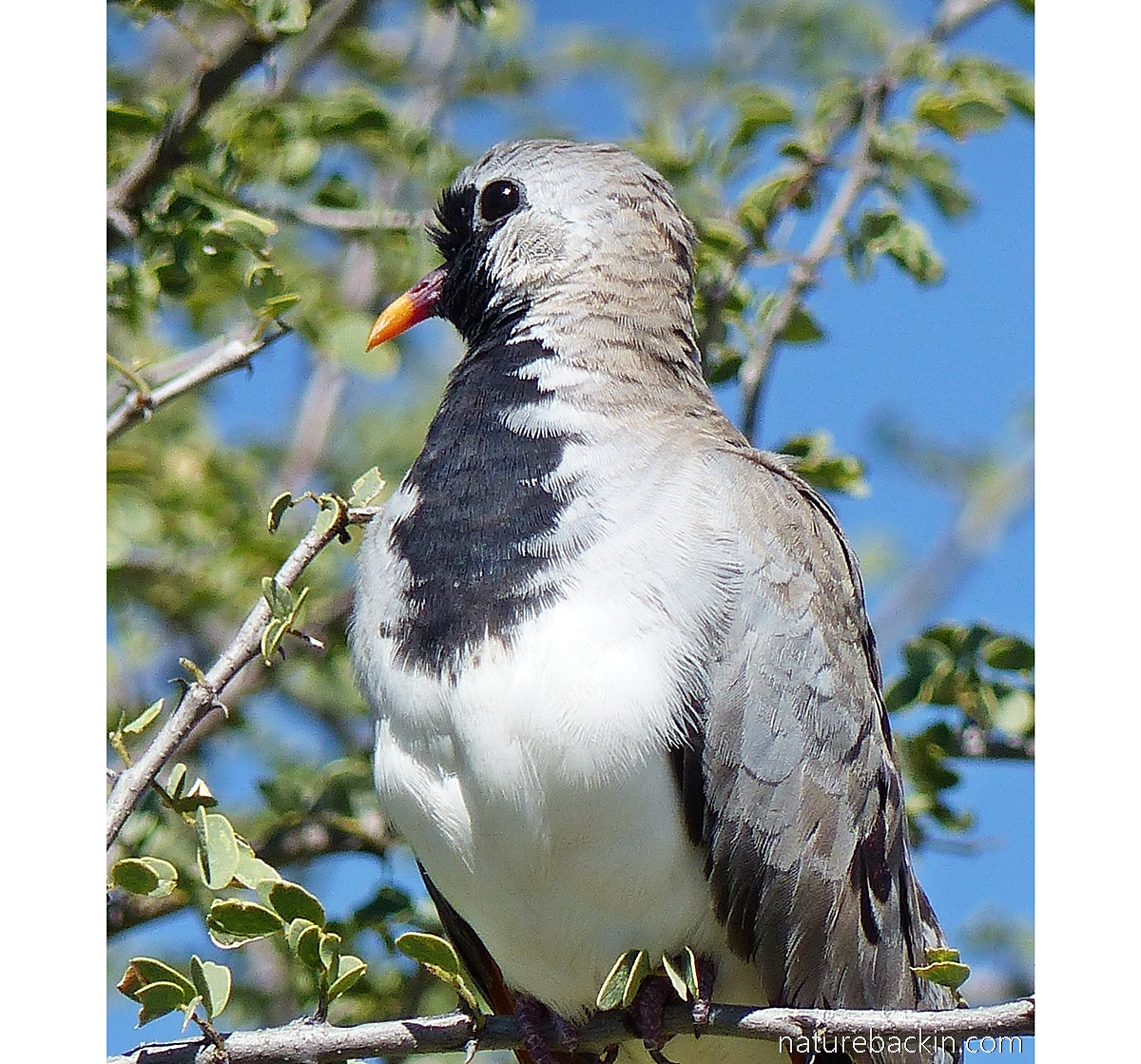





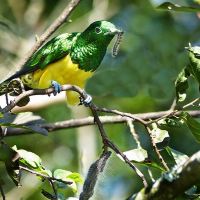
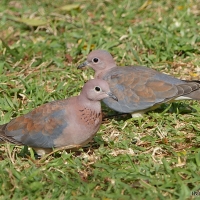
February 27, 2021 at 7:07 pm
Wow, thanks for slowing down the video clip multiple times. I finally saw the falcon. Fascinating to see the flurry as the pigeons scattered. I’ve seen Namaqua doves in the past at the Birding Center in Eilat. I wonder if they migrate up through that area, like so many other birds from Africa, or if they are also native to Israel?
LikeLiked by 1 person
February 27, 2021 at 7:44 pm
That is interesting that you saw Namaqua doves in Israel. It led me to look up their distribution and they do occur in parts of Israel and parts of the Arabian Peninsula and also in parts of Turkey. I had no idea they occurred there. Here is a link with a distribution map http://datazone.birdlife.org/species/factsheet/namaqua-dove-oena-capensis
Most interesting – thanks.
LikeLiked by 1 person
February 27, 2021 at 8:18 pm
Thanks for the link!
LikeLiked by 1 person
February 24, 2021 at 8:54 am
I enjoyed this very informative post and wonderful pics. The African olive pigeons are daily visitors to my garden and give the other pigeons rather a hard time.
LikeLiked by 1 person
February 27, 2021 at 1:50 pm
Thanks Christine. Here the olive pigeons are quite shy and despite their size they keep their distance from other birds and visits to the bird bath short and sweet.
LikeLike
February 13, 2021 at 11:03 pm
Great photos of the doves and pigeons. If you hadn’t included a slow motion version of the video, I’d have thought you were pulling our legs. It really a great way to show just how fast the falcon was.
LikeLiked by 1 person
February 14, 2021 at 5:58 am
Thanks Graham. 😊
Apparently lanners can even catch prey flying towards them. How fast must their reflexes be!
LikeLiked by 1 person
February 14, 2021 at 3:44 pm
I’d be easy pickings!
LikeLiked by 1 person
February 14, 2021 at 3:53 pm
🙂
LikeLike
February 13, 2021 at 7:04 pm
Thoroughly enjoyed this post, Carol. Your images are excellent. Terrific clarity and light. I especially enjoyed the shot of the dove drinking and the one looking over his shoulder. Interesting the variety of coloring and markings in the different types. Lots of great information- monogamy is always touching to me. And your video brings in a whole other dimension with the falcon!
LikeLiked by 1 person
February 13, 2021 at 7:44 pm
Thanks very much Jane. I really appreciate your kind comments. Taking photos when the sun is so high and bright and also from quite a distance away is a challenge. Looking back at these photos at the waterhole (taken in 2014) I was surprised to find that some were better than I had thought at the time!
The video was filmed in a very ad hoc kind of way, but it serves to convey an impression of just how incredibly fast the falcon flies in.
LikeLike
February 13, 2021 at 10:50 am
What fantastic shots and video, Carol!
The large flocks of doves and sandgrouse continuously coming and going at the waterholes in the Kgalagadi is of my most vivid memories of our visits to the Transfrontier Park. It amazed me to think that there’s enough food in that arid landscape to sustain such numbers.
LikeLiked by 1 person
February 14, 2021 at 3:46 pm
The sandgrouse are particularly lovely to see.
It is remarkable that such apparently arid regions sustain so much life.
LikeLiked by 1 person
February 13, 2021 at 10:07 am
Thanks for clearing up my confusion about the difference between doves and pigeons. The Namaqua doves are very handsome and seeing them in flight must be a wonderful sight. Thank you for that remarkable footage of the lanner falcon on the hunt.
LikeLiked by 1 person
February 14, 2021 at 3:46 pm
Yes the dove/pigeon distinction such that it is seems to be peculiar to the English language!
The Namaqua doves are wonderful – have you ever see any in the Eastern Cape?
LikeLike
February 14, 2021 at 4:27 pm
English language is idiosyncratic.
No, I haven’t seen any Namaqua doves here. I will check with my bird watching friend and let you know if they do occur in the EC
LikeLiked by 1 person
February 14, 2021 at 6:25 pm
Thanks Mariss. I gather they do occur in the region. For example, they are on the checklist of birds in Addo.
LikeLike
February 13, 2021 at 9:46 am
I’m entranced by these doves – other varieties of which we have here – gathering together at waterholes. We don’t see this type of behaviour at all (no waterholes!), and while these are not uncommon birds, gathered together in this way is not something that happens. Fascinating post. (I always say that)
LikeLiked by 1 person
February 14, 2021 at 3:42 pm
Thanks Margaret. I think the conditions in the semi-arid areas are rather extreme, and that intense gathering at the waterholes is characteristic of such regions. Many of the waterholes are artificial – there partly because fences prevent the old seasonal migrations from taking place.
LikeLiked by 1 person
February 14, 2021 at 4:09 pm
Really? I’m just reading Greenery by Timothy Dee, which is about -largely bird – migration (highly recommended by the way) and he mentions that some migration routes are becoming highly curtailed – though usually because climate change means that birds don’t have to travel so far to find the conditions they want. Fences sounds a different matter.
LikeLiked by 1 person
February 14, 2021 at 6:22 pm
Thanks for the recommendation. The anticipated and unanticipated effects of climate change seem to be countless.
Obviously the fences apply to the larger mammals and not to the birds 🙂
As an example, the book ‘Cry of the Kalahari’ (Mark and Delia Owens, 1984) documents the tragic impact of fences on wildebeest migrations in Botswana.
LikeLike
February 14, 2021 at 9:19 pm
I understand what you mean now. I’ll look out for this book. Thanks.
LikeLiked by 1 person
February 13, 2021 at 3:44 am
A fascinating overview of our local doves! Before our garden trees changed the environment from barren to forested, Cape Turtle Doves (Ring-necked – still to ‘ingest’ the change!) were common. They gradually retreated to the wide open street behind our home, where they feasted on syringa berries crushed by passing traffic. They were replaced by Laughing Doves, which I see in great numbers. A pair or two of Red-eyed Doves became residents a few years ago, enjoying the cover of the Natal fig and other trees. They are heard more than seen, although they occasionally join the other doves when I put seed out. Speckled Pigeons have moved into our roof – pretty to look at but a menace to house!
LikeLiked by 1 person
February 14, 2021 at 3:24 pm
That is interesting how the changing habitat in your garden altered the dove demographics. It confirms that Cape turtle doves (I also like their former name) prefer to forage in more open ground. It would seem that as grasslands are eliminated as tree plantations are expanded in so many areas, including in KZN, that they would be one of the species adversely effected.
The closest to where we live that I have seen speckled pigeons is at a small shopping centre ‘up the hill’ from us. I think I read somewhere that they often hybridize with feral pigeons
LikeLiked by 1 person
February 13, 2021 at 2:45 am
Dear Carol, I love your blog on doves, so often overlooked and such a gentle presence. We have the Laughing Dove here, but they keep to the periphery of our ‘garden’ area, it seems they aren’t competitive with the other resident bird species here. My favourite is seeing them spread their wings in winter sunshine on the ground to soak up the warmth. xxx
LikeLiked by 1 person
February 14, 2021 at 3:18 pm
Yes I also love watching them sunning themselves. It seems such a confiding thing to do. I am quite surprised that you don’t also get ring-necked doves.
I hope that you are also getting some of this weekend’s rain xxx
LikeLiked by 1 person
February 15, 2021 at 2:05 am
Lots of amazing, shifting clouds, but just a drop or two…. We do see ring-necked doves, but not often ❤ xxx
LikeLiked by 1 person
February 13, 2021 at 12:25 am
That is a fascinating clip of the falcon, boy they are fast! I love the red wings and markings (esp. the juvenile) of the Namaqua doves. I didn’t realize that there were so many different species of doves. We only have mourning doves here (and pigeons of course). Sadly, the US accounts for at least one of the extinctions, the passenger pigeon. Makes me ill to think there used to be millions, what the heck were they thinking? Dinner, and sport, I guess.
LikeLiked by 1 person
February 14, 2021 at 3:11 pm
Yes the speed of the falcon is incredible.
Btw, there is a African mourning dove (now called mourning collared dove), Streptopelia decipiens. Its range just reaches some of the northern parts of southern Africa. Looking up the American mourning dove I see it is an entirely different species (Zenaida macroura).
I was interested to read about it and saw that millions of the American mourning dove are shot each year and numbers are declining in part due to lead poisoning from eating lead shot.
Let’s hope something was learned from the extinction of the passenger pigeon, which also used to be so numerous! It is sickening as you say.
LikeLiked by 1 person
February 12, 2021 at 9:38 pm
Interesting as usual – luckily the clip could be seen in slow motion too. We have only got four dove species here in Sweden, but they are beautiful the few we have . The Namaqua doves have this long, beautiful tail – which none of ours up here have. The Eurasian collared dove is my favourite, and this winter we had six of them here. Last year one of them lost its partner – flew into one of our windows and didn’t recover. This year it seems there are three couples – so maybe he/she found a new friend. I hope so.
LikeLiked by 1 person
February 13, 2021 at 7:04 pm
Thanks Leya. I am happy to hear that you also appreciate doves. It can be saddening that they are so overlooked. It must have been distressing when the dove flew into a window, but hopefully the remaining bird did find a new partner as seems likely.
LikeLike
February 14, 2021 at 9:25 am
I hope so, this species is rare here, so I am happy to have some in my garden.
LikeLiked by 1 person
February 12, 2021 at 8:38 pm
Your ring-necked doves look very similar to our collared doves Streptopelia decaocto, which I see are in the same genus. Doves are often worth a second look – there is a delicate beauty about many of them, and of course their domesticated cousin has played a significant role in human history through carrying messages in conflicts.
That falcon looks very intense!
LikeLiked by 1 person
February 13, 2021 at 6:50 pm
I have just looked up the Streptopelia decaocto and I see the resemblance. I agree about the delicate beauty of doves and it is shame to take them for granted. It is remarkable that domestic pigeons played such a significant role!
I suppose the intense look of the falcon rather goes with the territory of being a raptor!
LikeLiked by 1 person
February 13, 2021 at 7:00 pm
Domestic pigeons have won more Dickin Medals (the animal equivalent of the Victoria Cross) than another species, saving many human lives. https://en.wikipedia.org/wiki/Dickin_Medal
LikeLiked by 1 person
February 13, 2021 at 7:00 pm
*any other. Oops.
LikeLiked by 1 person
February 13, 2021 at 7:29 pm
🙂
LikeLike
February 13, 2021 at 7:27 pm
What a fascinating record – thanks for the link. I had not known that bombers and other aircraft carried messenger pigeons to release in the event of being shot down. How incredible that any were able to survive and accomplish their mission.
I expect that if the awards had commenced in WW1 there would have been too many horses to count worthy of awards …
LikeLiked by 1 person